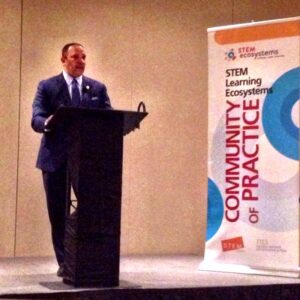By Gerald Solomon, Co-chair of the STEM Learning Ecosystem Initiative

Last night, the STEM Learning Ecosystems Initiative had the honor of welcoming Marc Morial, President and CEO of the National Urban League, to its Community of Practice gathering in Denver. I’ve had the pleasure of hearing Morial speak several times, and each time, I walk away inspired and motivated to roll up my sleeves and recommit to our effort. His remarks in Denver, shared with a room of STEM education advocates and experts from nearly 40 Ecosystems from across the country, were no exception.
As Ecosystems work tirelessly to cultivate their community architecture, build partnerships, and design STEM programing in their local communities, Morial affirmed why we do this critically important work in the first place. He helped us take a step back, reminding us that we will one day look back at this time in history and see this as the digital revolution. As a society, we often take for granted how changes in technology continue to affect our daily lives in profound and dramatic ways. The STEM Learning Ecosystems, therefore, have an awesome responsibility: We must ask ourselves, as we think about STEM moving forward, what is our North Star? What is the end game, and how do we get there? And most importantly, how do we respect and invest in ALL people, what he referred to as the human capital, to make sure ALL succeed?
The answer, which Morial shared through three guiding principles, drives the very work we continue to develop through STEM Learning Ecosystems.
First, STEM must be available to ALL individuals. We know all too well that African-American, Latino, low-income and female students remain dramatically underrepresented in STEM careers. Wide gaps persist in these students’ access to high-quality math and science learning. However, Morial reminded us that in order to close these gaps, we cannot be afraid to have uncomfortable conversations about equity. We cannot be afraid to debate it, to truly dig deep, not only to address the root of the problem, but also to envision what more equitable access to STEM looks like in our communities.
In addition, we must keep our focus on young people. “Our ability as a nation to be a leader relies on our ability to lift up the human capital our children represent,” said Morial. Equity for young people means access to all aspects of STEM—the inventive and creative aspects, the commercialization of STEM, employment pathways and quality of life benefits. And these STEM opportunities are critical for ALL young people from early childhood through adulthood.
Finally, we should prioritize STEM’s ability to improve our quality of life. This principle rang especially true for me, personally. The problem-solving, engineering design foundation of STEM, not to mention advances in technology, medicine, agriculture and manufacturing, gives us the power to better our world. With STEM, Morial explained, tomorrow’s innovators can address the Flint water crisis, build affordable and energy-efficient housing and discover the cures for cancer, diabetes and Alzheimer’s. That is why, STEM is not solely important for the sake of STEM; it touches everything, influencing our ability to create. “We must be engaged in a conversation about the morality of what we use [STEM] for—what we prioritize.” As Morial stated, we must empower communities to use STEM for good.
In the coming weeks, we will begin to share examples of the great work local STEM Ecosystems are doing that exemplify these principles. In particular, STEM Ecosystems across the country are ensuring that all learners, no matter their zip code, have access to high-quality STEM learning. I hope you’ll follow us on this blog as our STEM advocates tell their stories.
To learn more about STEM Learning Ecosystems, visit www.stemecosystems.org and follow us on Twitter at @STEMecosystems. To learn more about the National Urban League, visit www.nul.org.
